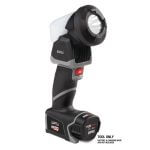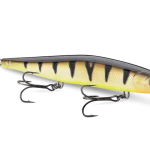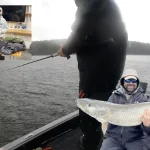Cold-Water jigging for Colorado River bass.
Lake Havasu in the southwest is known for its premier bass fishery. Thanks to the Lake Havasu Fisheries Improvement program, the lake now provides a more lived-in look for the fish, with an abundance of cover and food shelves. This has led to a significant increase in the population of both bait fish and predator fish, making it a thriving ecosystem.
The habitat program, which started in 1993 and ran for 10 years, initially faced skepticism. The PVC piping and orange highway fencing used as artificial habitats stood out in the water and were not utilized by the fish. However, everything changed when the quag muscle infestation occurred in 2005-2006. The quag muscles covered the artificial habitats, making them look natural and similar to rocks and wood. This led to the fish starting to use the artificial habitats, and they are now targeted by fishermen as they hold the biggest fish in the lake.
The impact of the habitat program on the bass fishery has been significant. The numbers and size of bass in Lake Havasu have seen a positive impact. The artificial habitats provide protection for the fish from predators, allowing them to thrive. The Smallmouth population has exploded, with hundreds of fish over 5 lbs being weighed in during the springtime. The Largemouth population has also seen growth, with multiple World Records and State records being set.
The introduction of quag muscles into the lake has had an interesting effect on the fishery. Local fishermen believe that the fish are eating the quag muscles, which has contributed to the increase in size of certain species, such as the red ear. The presence of quag muscles has also made the artificial habitats more appealing to the fish, as they now resemble natural structures like wood and rocks.
Lake Havasu is a popular destination for anglers, and the use of advanced fishing technology has made it even more accessible. The i-Pilot Link system by Humminbird and Minn Kota allows for precise boat control, enabling anglers to hold on a spot like an electronic anchor, record and return to waypoints and paths, and follow lake depth contours automatically. This technology has revolutionized fishing and made it easier for anglers to find and catch fish.
In addition to advanced technology, the use of specific fishing techniques and gear is crucial for success in Lake Havasu. Light line fishing is often necessary due to the clear water and the skittish nature of the fish. Anglers use a combination of light fluorocarbon line and braided line to increase their chances of getting a bite. The choice of line color can also make a difference, with white being a popular choice for visibility against the green water.
When it comes to bait selection, there are a few tried and true options that work well in Lake Havasu. Tube baits, black in color, have proven to be effective, as they mimic the natural prey of the fish. Other baits that work well include jigs and soft plastics, which can be used to imitate various types of forage. It’s important for anglers to pay attention to the color of their line, as it can make a difference in visibility and ultimately affect their success.
Lake Havasu offers a variety of fishing opportunities, and one of the most effective techniques is “tailing down.” This involves casting and working an area with finesse baits, such as drop shots or shaky heads, while keeping the bait close to the bottom. This technique can be particularly effective when the fish are being finicky or when they are cruising and moving around.
The advancements in fishing technology have also made a significant impact on fishing in Lake Havasu. Side imaging technology allows anglers to see underwater structures and habitats, making it easier to locate fish. This technology can be especially useful when scouting new areas or when fishing in unfamiliar waters. Additionally, the use of advanced sonar units, such as the Humminbird Helix, can provide anglers with a clear view of the underwater environment, helping them interpret what the unit is telling them.
Lake Havasu has undergone significant changes over the years, and it’s important for anglers to adapt their strategies accordingly. The lake now offers an abundance of cover and food shelves, making it a prime habitat for both bait fish and predator fish. By utilizing the right techniques, gear, and technology, anglers can increase their chances of success and have a memorable fishing experience on Lake Havasu.
In conclusion, Lake Havasu is a thriving bass fishery with a rich ecosystem thanks to the habitat program and the introduction of quag muscles. The artificial habitats have provided protection and food sources for the fish, leading to an increase in population and size. Advanced fishing technology, such as the i-Pilot Link system, has made fishing more accessible and efficient. Anglers must adapt their techniques and gear to the clear water and skittish nature of the fish. Tube baits, jigs, and soft plastics are popular bait choices, and “tailing down” is an effective technique. Side imaging technology and advanced sonar units help anglers locate fish and interpret underwater structures. Lake Havasu offers a unique fishing experience, and with the right strategies, anglers can have a successful and fulfilling time on the water.
How clear is the water at Lake Havasu and how does it impact fishing?
The water at Lake Havasu is exceptionally clear, allowing visibility of up to 16 feet deep. This clarity makes it ideal for spotting and tracking fish movements. Structures like cages and crates have been deliberately placed in the lake to provide cover and habitat for the fish. Despite not immediately seeing fish on the first day, the clear water eventually reveals their presence, particularly after extended exposure to sunlight. Overall, the remarkable clarity of Lake Havasu’s water enhances the fishing experience by enabling anglers to observe and target fish more effectively.
When is the best time to catch bass at Lake Havasu based on water temperature?
The best time to catch bass at Lake Havasu is when the surface water temperature reaches between 58 to 61 degrees Fahrenheit. At this temperature range, the bass start hitting their spawning beds and become super aggressive. It is ideal to be there when the water temperature is within this range to have the best chance of catching bass.
How can anglers adapt their fishing strategies based on local knowledge and online resources to improve their chances of catching bass at Lake Havasu?
Anglers can utilize local knowledge and online resources to identify potential fishing spots like Mesquite Cove & Copper Canyon. Techniques like the drop shot rig, recommended through online research, can be effective in crystal clear waters at Lake Havasu.
What type of bait and rigging techniques are effective for bass fishing in crystal clear water at Lake Havasu?
In crystal clear water at Lake Havasu, using a drop shot rig with small 3″ baits in green natural colors like a 3.5″ Yamamoto Watermelon Kut Tail Worm can be effective. Additionally, rigging the drop-shot baits weedless Texas style can prevent snagging.
Where should anglers focus their fishing efforts based on the water temperature variations in different parts of the lake?
Anglers should consider that bass may be moving in to spawn earlier in the lower end of the lake than the upper end. In the summer, the upper end may be cooler and have more fish, while in the fall, the lower end may stay warmer longer.
How do differences in water temperature between the upper and lower parts of the lake affect bass behavior?
The water was warmer near the dam in the lower part of the lake compared to the upper end where the Colorado River flows in. The cool river water from Mohave and Lake Mead chills the upper end, impacting bass behavior.
What are the ideal water temperatures for bass activity at Lake Havasu?
Bass at Lake Havasu get super aggressive when the water temperature hits 58 – 61 degrees, especially when they start hitting their spawning beds.
In order to enhance your bass fishing experience at Lake Havasu, consider the technique of ‘Cold-Water jigging for Colorado River bass.’ Understanding the behavior of bass in response to water temperature changes can greatly impact your success on the water. By focusing on the unique conditions of the lake, such as the temperature disparities between the upper and lower parts due to the influence of the Colorado River, anglers can strategically position themselves to target bass more effectively. While ‘Cold-Water jigging for Colorado River bass’ is a promising approach, it is essential to adapt your strategies based on the current conditions of the lake. Consider exploring various fishing methods and bait options to increase your chances of a successful catch. By staying informed through local knowledge and online resources, you can make informed decisions on where to fish and what techniques to use. Remember, the key to successful bass fishing lies in understanding the nuances of the lake environment and being adaptable in your approach.















